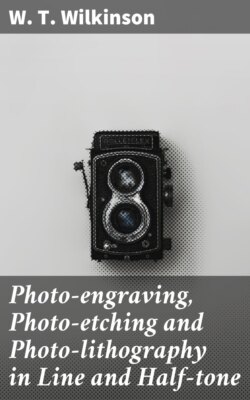Читать книгу Photo-engraving, Photo-etching and Photo-lithography in Line and Half-tone - W. T. Wilkinson - Страница 10
На сайте Литреса книга снята с продажи.
THE INTENSIFIER.
Оглавление| No. 1. | |||
|---|---|---|---|
| Water | 80 | ounces. | |
| Chloride of Ammonium | 2 | ounces. | |
| dissolve, then add: | |||
| Bichloride of Mercury | 2 | ounces. | |
| dissolve, and filter. | |||
| No. 2. | |||
| Liquor Ammonia 0.880 | 5 | ounces. | |
| Water | 20 | ounces. |
Solution No. 1 is best kept in an upright holder, as if kept in a flat dish there is always the danger of cutting the skin with the glass plate and getting the mercurial poison into the system.
No. 2 is kept in a well-stoppered bottle and only sufficient for each plate withdrawn as required.
Another method of intensifying, for those who object to the use of mercury, is to bleach the negative in a solution of
| Ferridcyanide of Potassium (Red Prussiate of Potash) | 6 | parts. |
| Nitrate of Lead | 4 | parts. |
| Water | 80 | parts. |
dissolve and filter. {19}
When the plate is bleached, wash it thoroughly under the tap, taking care that the edges and corners of the film as well as the centre are washed, then flood it with a sufficient quantity of
| Nitric Acid | 1 | ounce. | |
| Water | 80 | ounces. | |
| Allow this to remain on a few seconds, then wash, and flood with a sufficient quantity of | |||
| Sulphide of Ammonium | 1 | part. | |
| Water | 5 | parts. |
which will at once turn the film an intense black; again wash, and flood with the nitric acid solution, and again wash; then the negative is allowed to dry.
This method of intensifying is cheaper than the other, and if the washes of acid between and after the other two solutions are carefully done, and the stench of the sulphide is not objected to, then there is little or no difference in the results; but if the acid washes are omitted or (and) the sulphide has not been kept corked, and is consequently not fresh, then there is great danger of a brown stain upon the lines, which is more or less fatal to getting a good print on zinc.
For half-tone negatives, instead of fixing or clearing with the cyanide of potassium, the developer is washed off directly, and then they are intensified at once by the application of a mixture of pyrogallic acid, citric acid, and nitrate of silver, as follows:
| No. 1 Solution of Pyrogallic Acid | 40 | grains. | |
| Citric Acid | 30 | grains. | |
| Water | 20 | ounces. | |
| As much of this solution as will cover the washed plate is put into a small cup, and flowed all over the film, then returned to the cup, and a few drops of | |||
| Nitrate of Silver | 30 | grains. | |
| Water | 1 | ounce. |
is added. Then the mixture is poured over the film, and rocked to and fro for a short time; the intensifier is then returned to the cup, the negative held up to the light, and examined, and if not intense enough, the intensifier is again applied. Great care is requisite at this stage, as if the process be carried on too {20} far the negative will be too intense, and will either be spoiled, or take an abnormal time to print; practice and observation are the only guides to success. The grand rules for half-tone negatives are, collodion free from dust, the glass plate clean, the bath at its full strength and in good working order, proper time allowed the plate in the sensitizing bath, well drained, afterward a good exposure, develop until all details are out, then wash thoroughly, intensify with judgment, wash well, fix, and again well wash, and then, but never till then, open the dark-room door and examine your new negative by daylight.
In making the collodion, soak the celloidin in the ether for about twelve hours before adding the alcohol; be sure the ether is at least 0.725 specific gravity, and that the alcohol is very clean, and free from gum. After mixing the collodion and iodizer, shake up well, but do not do this before decanting. Always decant sufficient for next day’s use, into the bottle used for pouring, over night, so that it gets a chance to settle, and allows the air-bubbles to escape.
Keep the collodion in as cool a place as possible, and in decanting it be very careful to do it away from fire, or lighted gas or paraffine, especially where flame is below the bottle, as ether vapor does not rise, but falls.
In hot weather and during long exposures, wet plates are very prone to have a peculiar stain upon them, called oyster-shell markings, the remedies for which are careful draining before putting them into the slide, and covering the bottom of the carrier with clean filtering paper, so that the silver solution, on draining down, is absorbed by the bibulous paper instead of going back up the plate by capillary attraction.
In hot weather the back of the plate, when put into the dark slide, should be covered with a wet piece of red blotting paper, or orange calico, but not white; a wet cloth laid in the camera will also tend to keep the plate moist. These precautions, however, are not required unless the exposure is likely to exceed a quarter of an hour.
